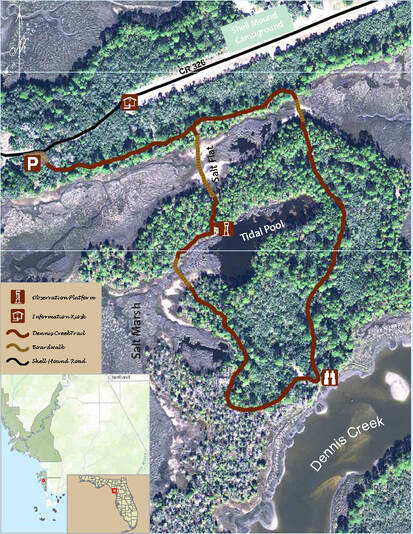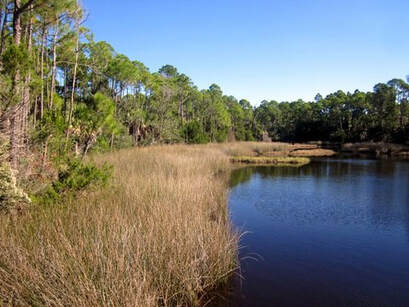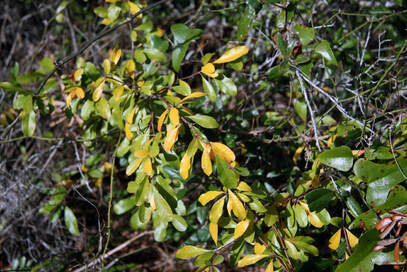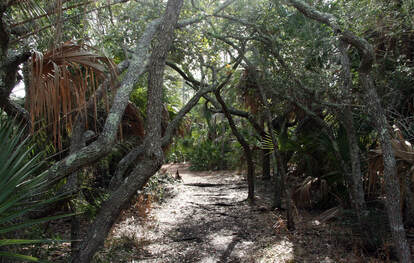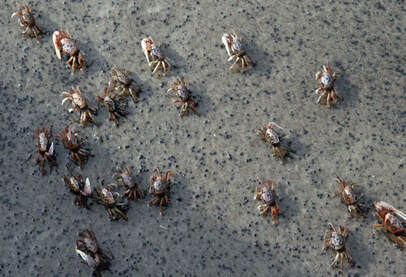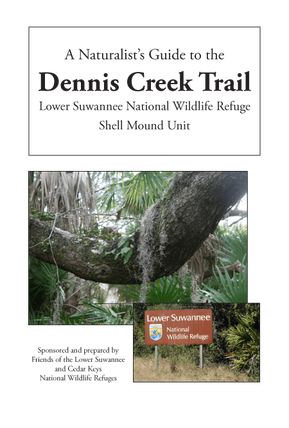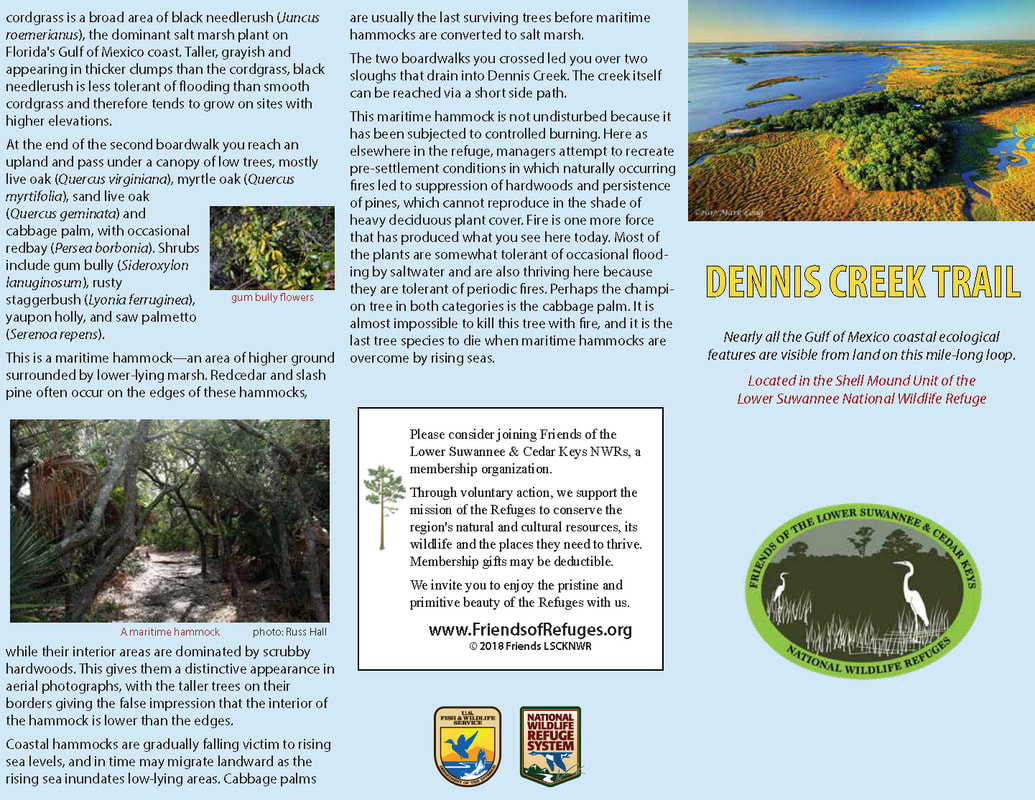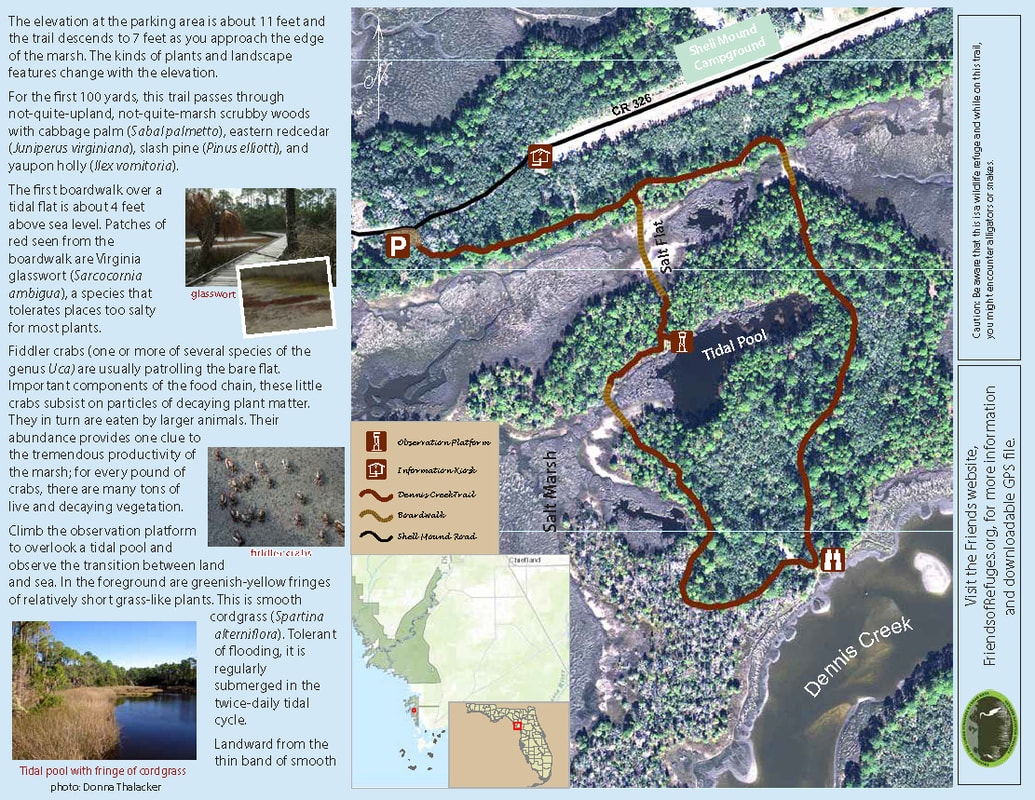Dennis Creek Trail |
Nearly all the Gulf of Mexico coastal ecological features are visible from land on this mile-long loop.
|
The elevation at the parking area is about 11 feet and the trail descends to 7 feet as you approach the edge of the marsh. The kinds of plants and landscape features change with the elevation.
For the first 100 yards, this trail passes through not-quite-upland, not-quite-marsh scrubby woods with cabbage palm (Sabal palmetto), eastern redcedar (Juniperus virginiana), slash pine (Pinus elliotti), and yaupon holly (Ilex vomitoria). The first boardwalk over a tidal flat is about 4 feet above sea level. Patches of red seen from the boardwalk are Virginia glasswort (Sarcocornia ambigua), a species that tolerates places too salty for most plants. Fiddler crabs (one or more of several species of the genus Uca) are usually patrolling the bare flat. Important components of the food chain, these little crabs subsist on particles of decaying plant matter. They in turn are eaten by larger animals. Their abundance provides one clue to the tremendous productivity of the marsh; for every pound of crabs, there are many tons of live and decaying vegetation. Climb the observation platform to overlook a tidal pool and observe the transition between land and sea. In the foreground are greenish-yellow fringes of relatively short grass-like plants. This is smooth cordgrass (Spartina alterniflora). Tolerant of flooding, it is regularly submerged in the twice-daily tidal cycle. Landward from the thin band of smooth cordgrass is a broad area of black needlerush (Juncus roemerianus), the dominant salt marsh plant on Florida's Gulf of Mexico coast. Taller, grayish and appearing in thicker clumps than the cordgrass, black needlerush is less tolerant of flooding than smooth cordgrass and therefore tends to grow on sites with higher elevations. At the end of the second boardwalk you reach an upland and pass under a canopy of low trees, mostly live oak (Quercus virginiana), myrtle oak (Quercus myrtifolia), sand live oak (Quercus geminata) and cabbage palm, with occasional redbay (Persea borbonia). Shrubs include gum bully (Sideroxylon lanuginosum), rusty staggerbush (Lyonia ferruginea), yaupon holly, and saw palmetto (Serenoa repens). This is a maritime hammock—an area of higher ground surrounded by lower-lying marsh. Redcedar and slash pine often occur on the edges of these hammocks, while their interior areas are dominated by scrubby hardwoods. This gives them a distinctive appearance in aerial photographs, with the taller trees on their borders giving the false impression that the interior of the hammock is lower than the edges. Coastal hammocks are gradually falling victim to rising sea levels, and in time may migrate landward as the rising sea inundates low-lying areas. Cabbage palms are usually the last surviving trees before maritime hammocks are converted to salt marsh. The two boardwalks you crossed led you over two sloughs that drain into Dennis Creek. The creek itself can be reached via a short side path. This maritime hammock is not undisturbed because it has been subjected to controlled burning. Here as elsewhere in the refuge, managers attempt to recreate pre-settlement conditions in which naturally occurring fires led to suppression of hardwoods and persistence of pines, which cannot reproduce in the shade of heavy deciduous plant cover. Fire is one more force that has produced what you see here today. Most of the plants are somewhat tolerant of occasional flooding by saltwater and are also thriving here because they are tolerant of periodic fires. Perhaps the champion tree in both categories is the cabbage palm. It is almost impossible to kill this tree with fire, and it is the last tree species to die when maritime hammocks are overcome by rising seas. |

Friends of the Lower Suwannee & Cedar Keys National Wildlife Refuges
P. O. Box 532 Cedar Key, FL 32625 [email protected] We are a 501(c)(3) nonprofit organization. |
|
